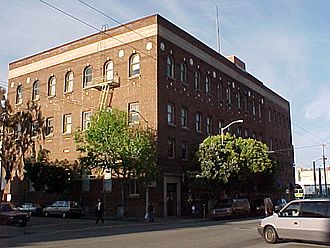Redstone Building facts for kids
Quick facts for kids The Redstone Building |
|
|---|---|

The San Francisco Labor Temple known today as the Redstone Building
|
|
| General information | |
| Status | Complete |
| Type | offices and community center |
| Location | 2926-48 16th Street San Francisco |
| Coordinates | 37°45′55.34″N 122°25′5.66″W / 37.7653722°N 122.4182389°W |
| Construction started | 1914 |
| Completed | 1915 |
| Opening | 1915 |
| Renovated | 1939 (addition) |
| Cost | USD $150,000 |
| Owner | David Luchessi |
| Technical details | |
| Structural system | Steel-reinforced brick facade |
| Floor count | 3 |
| Floor area | 50,000 square feet (4,600 m2) |
| Lifts/elevators | 1 |
| Design and construction | |
| Architect | Matthew O'Brien |
| Main contractor | New Wing – Moore & Roberts |
| Designated: | 2004 |
| Reference #: | 238 |
The Redstone Building, also known as the Redstone Labor Temple, is a historic building in San Francisco. It was built and run by a group called the San Francisco Labor Council Hall Associates. Planning for the building started in 1910, and most of the construction happened in 1914.
The main group that used the building was the San Francisco Labor Council. This council is a group of different labor unions working together. A labor union is an organization of workers who join together to protect their rights and improve their working conditions, like getting fair pay or safer workplaces. The Redstone Building had offices for 22 different labor unions and many meeting rooms.
For over 50 years, the Redstone Building was a very important place for workers in San Francisco. It was a busy center where unions organized and planned activities to help workers.
A Place for Workers' Rights
The Redstone Building played a big part in important events for workers. In 1917, it was involved in the United Railroads Streetcar Strike. This was when streetcar workers stopped working to demand better conditions.
Later, the building was also key during the San Francisco maritime strike. This strike involved workers who worked on ships and at the docks. This led to the 1934 San Francisco General Strike. During this huge strike, many different types of workers across the city stopped working. They all wanted better working conditions and fair treatment.
The Redstone Building is now recognized as a special historical landmark in San Francisco. It is the city's 238th landmark, showing its importance in the history of workers' rights.
Images for kids


